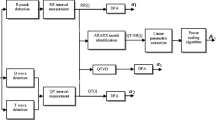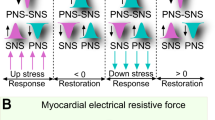Abstract
The cellular action potential of cardiac muscles generates Electrocardiogram (ECG) signals. Disturbances in cardiac cells are determined by analyzing the stability of ECG intervals. The PTa Interval (PTaI) of ECG represents the atrial Action Potential Duration (APD) and the evaluation of the causes of PTaI instability can predict the onset of arrhythmia. This study developed an Autoregressive Moving Average with Exogenous Input (ARMAX) model to explore the roles of Heart Rate Variability (HRV) and Premature Activation (PA) in PTaI dynamics using PTaI and PP Interval (PPI) as exogenous inputs. Minute ECG signals were collected from twenty Normal Sinus Rhythm (NSR) and ten Atrial Tachycardia (AT) volunteers. The EDAN PC ECG system was used in the Modified Limb Lead (MLL) configuration to evaluate instability. The instabilities of PTaI were found at the minimum model orders (Amin) of 10 and 11, in the NSR and AT groups, respectively. In the NSR group, the predominant reason for PTaI instability was HRV, whereas among AT patients, it was largely due to PA that preceded the onset of AT. The proposed model showed better prediction of PTaI with minimum Mean Square Error (MSE) between the measured and predicted PTa Intervals (PTaIs). The factor that led to PTaI instability in AT patients was found to be different from that of the NSR group. The frequency of PA (fPA) was found to contribute more in the AT than the NSR group. The developed ARMAX model was better in predicting instability of atrial ECG dynamics in both groups than other autoregressive models currently in use.







Similar content being viewed by others
References
Prystowsky EN (1995) Tachycardia-induced tachycardia: a mechanism of initiation of atrial fibrillation. In: Di Marco JP, Prystowsky EN (eds) Atrial arrhythmias. State of the art. Futura Publishing Company, Armonk, pp 81–95
Delise P, Coro L, Scipione P, Fantinel M (1998) Tachycardia induced atrial fibrillation: what incidence? How to diagnose and treat it. In: Raviele A (ed) Cardiac arrhythmias 1997. Springer, Milano, pp 18–23. https://doi.org/10.1007/978-88-470-2288-1_3
Magnani JW, Williamson MA, Ellinor PT, Monahan KM et al (2009) P wave indices current status and future directions in epidemiology, clinical, and research applications. Circ Arrhythm Electrophysiol 2:72–79. https://doi.org/10.1161/CIRCEP.108.806828
Eranti A, Carlson J, Kentta T, Holmqvist F et al (2020) Orthogonal P-wave morphology, conventional P-wave indices, and the risk of atrial fibrillation in the general population using data from the Finnish Hospital Discharge Register. Europace. https://doi.org/10.1093/europace/euaa118
Rasmussen MU, Kumarathurai P, Bjerre AF, Larsen BS et al (2020) P-wave indices as predictors of atrial fibrillation. Ann Noninvas Electrocardiol 00:e12751. https://doi.org/10.1111/anec.12751
Platonov PG (2012) P-wave morphology: underlying mechanisms and clinical implications. Ann Noninvas Electrocardiol 17:161–169. https://doi.org/10.1111/j.1542-474X.2012.00534.x
Kaplan DT, Furman MI, Pincus SM, Ryan SM et al (1991) Aging and the complexity of cardiovascular dynamics. Biophys J 59:945–949. https://doi.org/10.1016/S0006-3495(91)82309-8
Havmoller R, Carlson J, Holmqvist F, Herreros A et al (2007) Age-related changes in P wave morphology in healthy group. BMC Cardiovasc Disor. https://doi.org/10.1186/1471-2261-7-22
German DM, Kabir MM, Dewland TA, Henrikson CA et al (2016) Atrial fibrillation predictors: Importance of the electrocardiogram. Ann Noninvas Electrocardiol 21:20–29. https://doi.org/10.1111/anec.12321
Childers R (2011) Atrial repolarization: Its impact on electrocardiography. J Electrocardiol 44:635–640. https://doi.org/10.1016/j.jelectrocard.2011.07.031
Tanabe J, Tanabe K (2020) False positive ST segment elevation. Eur Heart J Case Rep 4:1–2. https://doi.org/10.1093/ehjcr/ytaa018
Debbas NM, Jackson SH, Jonghe D, Robert A, Camm AJ (1999) Human atrial repolarization: effects of sinus rate, pacing and drugs on the surface electrocardiogram. J Am Coll Cardiol 33:358–365. https://doi.org/10.1016/s0735-1097(98)00580-4
Kališnik JM, Avbelj V, Vratanar J, Santarpino G et al (2019) Cardiac autonomic regulation and PR interval determination for enhanced atrial fibrillation risk prediction after cardiac surgery. Int J Cardiol 15:24–29. https://doi.org/10.1016/j.ijcard.2019.04.070
Wallace E, Howard L, Liu M, O’Brien T et al (2019) Long QT syndrome: genetics and future perspective. Pediatr Cardiol 40:1419–1430. https://doi.org/10.1007/s00246-019-02151-x
El-Sherif N, Turitto G, Boutjdir M (2019) Acquired long QT syndrome and electrophysiology of Torsade de Pointes. Arrhythm Electrophysiol Rev 8:122–130. https://doi.org/10.15420/aer.2019.8.3
El-Sherif N, Turitto G, Boutjdir M (2018) Acquired long QT syndrome and Torsade de Pointes. Pacing Clin Electrophysiol 41:414–421. https://doi.org/10.1111/pace.13296
Yao L, Li P, Liu C, Hou Y et al (2019) Comparison of QT interval variability of coronary patients without myocardial infarction with that of patients withold myocardial infarction. Comput Biol Med 113:103396. https://doi.org/10.1016/j.compbiomed.2019.103396
Mittal S (2019) QT interval—its measurement and clinical significance. J Clin Prev Cardiol 8:71–79. https://doi.org/10.4103/JCPC.JCPC_44_18
Szydlo K, Trusz-Gluza M, Wita K, Filipecki A et al (2008) QT/RR relationship in patients after remote anterior myocardial infarction with left ventricular dysfunction and different types of ventricular arrhythmias. Ann Noninvas Electrocardiol 13:61–66. https://doi.org/10.1111/j.1542-474X.2007.00201.x
Couderc JP (2009) Measurement and regulation of cardiac ventricular repolarization: from the QT interval to repolarization morphology. Philos Trans A Math Phys Eng Sci 367:1283–1299. https://doi.org/10.1098/rsta.2008.0284
Zaman JAB, Narayan SM, Franz MR (2020) Action potential dynamics in human atrial fibrillation. In: El-Sherif N (ed) Cardiac Repolariz. Springer, Cham, pp 333–345
Narayan SM, Franz MR, Clopton P, Pruvot EJ et al (2011) Repolarization alternans reveals vulnerability to human atrial fibrillation. Circ 123:2922–2930. https://doi.org/10.1161/CIRCULATIONAHA.110.977827
Ni H, Zhang H, Grandi E, Narayan SM et al (2018) Transient outward K + current can strongly modulate action potential duration and initiate alternans in human atrium. Am J Physiol Heart CircPhysiol 316:H527–H542. https://doi.org/10.1152/ajpheart.00251.2018
Nolasco JB, Dahlen RW (1968) A graphic method for the study of alternation in cardiac action potentials. J Appl Physiol 25:191–196. https://doi.org/10.1152/jappl.1968.25.2.191
Kesmia M, Boughaba S, Jacquir S (2019) Nonlinear dynamics of two-dimensional cardiac action potential duration mapping model with memory. J Math Biol 78:1529–1552. https://doi.org/10.1007/s00285-018-1318-7
Halamek J, Jurak P, Lipoldova J, Leinveber P et al (2010) QT/RR coupling and gender differences. Comput Cardiol 37:365–368
Chen X, Trayanova NA (2012) A novel methodology for assessing the bounded-input bounded-output instability in QT interval dynamics: application to clinical ECG with ventricular tachycardia. IEEE Trans Biomed Eng 59:2111–2117. https://doi.org/10.1109/TBME.2011.2170837
Imam MH, Karmakar CK, Khandoker AH, Palaniswami M (2013) Effect of premature activation in analyzing QT dynamics instability using QT-RR model for ventricular fibrillation and healthy group. In: Proc Ann Int Conf IEEE Eng Med Biol Soc EMBS 25592562. https://doi.org/10.1109/embc.2013.6610062
Acharya UR, Joseph KP, Kannathal N, Lim CM et al (2006) Heart rate variability: a review. Med Biol Eng Comput 44:1031–1051. https://doi.org/10.1007/s11517-006-01190
Sivaraman J, Uma G, Venkatesan S, Umapathy M et al (2015) Normal limits of ECG measurements related to atrial activity using a modified limb lead system. Anatol J Cardiol 15:2–6. https://doi.org/10.5152/akd.2014.5155
Sivaraman J, Uma G, Umapathy M (2012) A modified chest leads for minimization of ventricular activity in electrocardiograms. In: Proc Int Conf Biomed Eng Penang, Malaysia, pp 79–82. https://doi.org/10.1109/ICoBE.2012.6178959
Sivaraman J, Uma G, Venkatesan S, Umapathy M et al (2013) A novel approach to determine atrial repolarization in electrocardiograms. J Electrocardiol 46:e1. https://doi.org/10.1016/j.jelectrocard.2013.05.009
Sivaraman J, Renu J (2017) Effects of sinus rhythm on atrial ECG components using modified limb lead system. In: Int Conf Signal Proc Compt and Control, pp 527–530. https://doi.org/10.1109/ISPCC.2017.8269735.
Jayaraman S, Sangareddi V, Periyasamy R, Joseph J (2017) Modified limb lead ECG system effects on electrocardiographic wave amplitudes and frontal plane axis in sinus rhythm group. Anatol J Cardiol 17:46–54. https://doi.org/10.14744/AnatolJCardiol.2016.6843
Sivaraman J, Uma G, Venkatesan S, Umapathy M et al (2014) A study on atrial Ta wave morphology in healthy group: an approach using P wave signal-averaging method. J Med Imaging Health Inform 4:675–680. https://doi.org/10.1166/jmihi.2014.1306
Sivaraman J, Uma G, Langley P, Umapathy M (2016) A study on stability analysis of atrial repolarization variability using ARX model in sinus rhythm and atrial tachycardia ECGs. Comput Methods Programs Biomed 137:341–351. https://doi.org/10.1016/j.cmpb.2016.10.005
Huikuri HV, Valkama JO, Airaksinen KE, Seppanen T (1993) Frequency domain measures of heart rate variability before the onset of nonsustained and sustained ventricular tachycardia in patients with coronary artery disease. Circulation 87:1220–1228. https://doi.org/10.1161/01.cir.87.4.1220
Almeida R, Gouveia S, Rocha AP, Pueyo E et al (2006) QT variability and HRV interactions in ECG: quantification and reliability. IEEE Trans Biomed Eng 53:1317–1329. https://doi.org/10.1109/TBME.2006.873682
Porta A, Tobaldini E, Gnecchi-Ruscone T, Montano N (2010) RT variability unrelated to heart period and respiration progressively increases during graded head-up tilt. Am J Physiol 298:1406–1415. https://doi.org/10.1152/ajpheart.01206.2009
Acknowledgements
The authors acknowledge the support from the Ministry of Education, Government of India. The present study was supported by financial grants from the Science Engineering Research Board (SERB), Department of Science and Technology (DST), Government of India (EEQ/2019/000148).
Author information
Authors and Affiliations
Corresponding author
Ethics declarations
Conflict of interest
None of the authors have any conflict of interest in this study.
Ethical approval
All procedures performed in studies involving human participants were in accordance with the ethical standards of the institutional committee and with the 1964 Helsinki declaration and its later amendments or comparable ethical standards.
Informed consent
Informed consent was obtained from all individual participants included in the study.
Additional information
Publisher's Note
Springer Nature remains neutral with regard to jurisdictional claims in published maps and institutional affiliations.
Rights and permissions
About this article
Cite this article
Arumughan, J., Bhardwaj, A. & Sivaraman, J. Stability analysis on the effects of heart rate variability and premature activation of atrial ECG dynamics using ARMAX model. Phys Eng Sci Med 43, 1361–1370 (2020). https://doi.org/10.1007/s13246-020-00940-w
Received:
Accepted:
Published:
Issue Date:
DOI: https://doi.org/10.1007/s13246-020-00940-w




